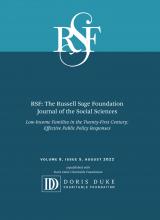Research Article
Open Access
Fixing a Leaky U.S. Social Safety Net: Diapers, Policy, and Low-Income Families
Jennifer Randles
RSF: The Russell Sage Foundation Journal of the Social Sciences August 2022, 8 (5) 166-183; DOI: https://doi.org/10.7758/RSF.2022.8.5.08
Jennifer Randles
aProfessor and chair of sociology at California State University, Fresno, United States

REFERENCES
- ↵
- ↵
- Allard, Scott W
- ↵
- Azevedo-McCaffrey, Diana, and
- Ali Safawi
- ↵
- Barroso, Amanda, and
- Rakesh Kochhar
- ↵
- Cardoso, Lauren F.,
- Anna M. Scolese,
- Alzahra Hamidaddin, and
- Jhumka Gupta
- ↵
- Carlson, Marcia J.,
- Christopher Wimer, and
- Ron Haskins
- ↵
- Carstensen, Fred, and
- Peter Gunther
- ↵
- Danielson, Caroline, and
- Sarah Bohn
- ↵
- Danziger, Sandra K.,
- Sheldon Danziger,
- Kristin S. Seefeldt, and
- H. Luke Shaefer
- ↵
- Deterding, Nicole M., and
- Mary C. Waters
- ↵
- Gordon, Linda
- ↵
- Halpern-Meekin, Sarah,
- Kathryn Edin,
- Laura Tach, and
- Jennifer Sykes
- ↵
- Halpern-Meekin, Sarah, and
- Adam Talkington
- ↵
- Hays, Sharon
- ↵
- Joshi, Pamela,
- Abigail N. Walters,
- Clemens Noelke, and
- Dolores Acevedo-Garcia
- ↵
- Kane, Jennifer B.,
- Timothy J. Nelson, and
- Kathryn Edin
- ↵
- Koball, Heather, and
- Yang Jiang
- ↵
- Livingston, Gretchen
- ↵
- Luhr, Sigrid,
- Daniel Schneider, and
- Kristen Harknett
- ↵
- Massengale, Kelley E. C.,
- Lynn H. Comer,
- Anna E. Austin, and
- Joanne S. Goldblum
- ↵
- Massengale, Kelley E. C.,
- Jennifer Toller Erausquin, and
- Michelle Old
- ↵
- Meyer, Laura, and
- Ife Floyd
- ↵
- Michelmore, Katherine M., and
- Natasha V. Pilkauskas
- ↵
- National Diaper Bank Network
- ↵
- Parolin, Zachary,
- Sophie Collyer,
- Megan A. Curran, and
- Christopher Wimer
- ↵
- ↵
- Raver, Cybele,
- Nicole Letourneau,
- Jennifer Scott, and
- Heidi D’Agostino
- ↵
- Safawi, Ali, and
- Cindy Reyes
- ↵
- Seefeldt, Kristin, and
- Heather Sandstrom
- ↵
- Smith, Megan V.,
- Anna Kruse,
- Alison Weir, and
- Joanne Goldblum
- ↵
- ↵
- Tach, Laura, and
- Kathryn Edin
- ↵
- Thaman, Lauren A., and
- Lawrence F. Eichenfield
- ↵
- Timmermans, Stefan, and
- Iddo Tavory
- ↵
- U.S. Census Bureau
- ↵
- U.S. Department of Agriculture
- ↵
- U.S. Department of Health and Human Services
- ↵
- U.S. Department of Labor
- ↵
- Wallace, Lori R.,
- Alison M. Weir, and
- Megan V. Smith
- ↵
- Zippel, Claire
In this issue
Fixing a Leaky U.S. Social Safety Net: Diapers, Policy, and Low-Income Families
Jennifer Randles
RSF: The Russell Sage Foundation Journal of the Social Sciences Aug 2022, 8 (5) 166-183; DOI: 10.7758/RSF.2022.8.5.08
Jump to section
Related Articles
- No related articles found.
Cited By...
- No citing articles found.





